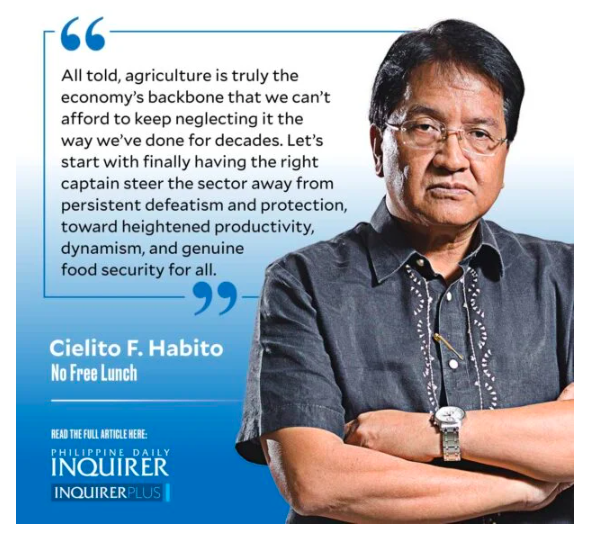The economy’s backbone

Over the years, I have described agriculture as the economy’s backbone. While I believe this to be true nearly everywhere, it’s more especially so for the Philippine economy. Many might find it hard to agree, especially considering how by various measures, it has been our worst performing economic sector for decades now—that is, compared to the two other sectors of industry and services. For one, agriculture, forestry, and fishery (AFF) now accounts for less than a tenth (9.6 percent) of our gross domestic product (GDP), way down from one-third in the postwar years of 1946-1947.
It’s not because the sector shrank. It kept growing over the years, but at a rate much slower than industry and services did. Since the turn of the millennium, AFF grew at an average annual rate of only 2.4 percent, far outstripped by the 4.6 and 5.7 percent for industry and services, respectively. And it had worsened over time; the sector’s annual growth averaged 3.5 percent in 2001-2010 (vs. 4.2 and 5.6 percent for industry and services, respectively), but has been a mere 1.5 percent per year from 2011 onwards. Meanwhile, industry and services both speeded up to 5.0 and 5.8 percent average annual growth, respectively. Productivity (in constant 2018 pesos) per worker in AFF was only P164,982 last year, far below industry’s P689,059 and services’ P444,045. Not surprisingly, our nation’s poorest are found in our farms and fisheries.
With such dismal numbers, how can we say agriculture is our economy’s backbone, then? Consider the following facts. Only two regions, Metro Manila and Calabarzon, already account for more than half of our total services GDP. In industry GDP, only three regions account for 60 percent, with the addition of Central Luzon to the previous two. All three regions are in Luzon. On the other hand, AFF output is much more evenly spread across the regions, with six of the 16 regions accounting for half, including one region in Visayas and three in Mindanao. It is, quite literally, the sector holding our regions together like a backbone, commonly important in all of our regions. Thus, I also describe it as our economy’s most inclusive sector, because growth in the sector benefits all regions of the country, in contrast to the highly skewed (and Luzon-centric) geographical benefits from growth in industry and services. Just like in the human body, other parts of the body could well be in much better shape than our spine—but it’s still the backbone that holds it all together.
Our backbone sector showed its mettle at the height of the COVID-19 pandemic. In 2020, when industry and services suffered deep contractions at -13.1 and -9.1 percent, respectively, AFF dipped a mere -0.2 percent. But it turned negative only because African swine fever had abnormally reduced livestock production. If livestock is omitted from the computation, the rest of the sector actually grew by a positive 0.8 percent. Crops alone posted an impressive 2.1 percent growth even as the rest of the economy collapsed! At the same time, statistics showed that the AFF sector absorbed hundreds of thousands of workers displaced from industry and services. Agriculture, apart from showing resilience in adversity, also proved to be the reliable fallback jobs provider—a true backbone indeed.
Furthermore, agriculture is a key foundation on which our industry and services sectors are built. It provides the raw materials for about two-thirds of our manufacturing output (of which more than half are food manufacturers), which in turn is about two-thirds of the total industry sector output. In services, agriculture and agri-based products also figure prominently in the dominant services subsectors of wholesale and retail trade, transport and storage, food and accommodation services, and now tourism as well, with farm tourism fast gaining ground.
All told, agriculture is truly the economy’s backbone that we can’t afford to keep neglecting it the way we’ve done for decades. Let’s start with finally having the right captain steer the sector away from persistent defeatism and protection, toward heightened productivity, dynamism, and genuine food security for all.
cielito.habito@gmail.com
Disclaimer: The comments uploaded on this site do not necessarily represent or reflect the views of management and owner of Cebudailynews. We reserve the right to exclude comments that we deem to be inconsistent with our editorial standards.
